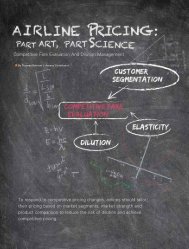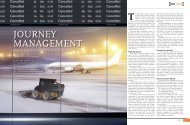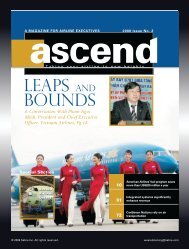2009 Issue 1 - Sabre Airline Solutions
2009 Issue 1 - Sabre Airline Solutions
2009 Issue 1 - Sabre Airline Solutions
Create successful ePaper yourself
Turn your PDF publications into a flip-book with our unique Google optimized e-Paper software.
Last year, the airline industry saw the most<br />
dramatic cuts in capacity since 9/11, with<br />
promises of more to come. As oil prices<br />
continued to soar up to an eventual peak of<br />
US$147 a barrel, airline executives saw no<br />
option but to take drastic action — reducing<br />
capacity. The belief was the action would<br />
result in lower costs and that removing seats<br />
would sustain or even boost ticket prices, leading<br />
to an increase in yields.<br />
“The events allowed for needed capacity<br />
reductions that wouldn’t have happened otherwise,”<br />
said Robert Crandall, former chairman and<br />
chief executive officer of AMR Corp.’s American<br />
<strong>Airline</strong>s, during the 2008 <strong>Airline</strong> Strategy Summit in<br />
London. “It is this ruthless reduction in seats that<br />
will preserve ticket prices and margins and thus<br />
ensure that a few carriers survive.”<br />
Although the action was taken as a result of<br />
oil prices, which have since declined significantly, it<br />
appears the right decision was made for an unexpected<br />
reason — the abrupt softening of demand.<br />
Whether the decision was good luck or good judgment,<br />
the capacity decreases could not have come<br />
at a better time.<br />
Early signs of a slowing economy started<br />
to snowball with banks and financial institutions<br />
reaching crisis point and governments providing<br />
huge bailout packages. The inevitable cuts in corporate<br />
travel budgets and leisure travel followed, and<br />
demand softened noticeably. Numerous predictions<br />
have been made on the revenue impacts to the<br />
industry. The International Air Transport Association<br />
has forecasted a fall of US$36 billion in revenues<br />
compared to the last downturn, which saw a drop<br />
of US$1 billion. Others have forecasted decreases to<br />
lesser or more severe degrees, but all have agreed<br />
that the airline industry is facing one of its most<br />
challenging years.<br />
Capacity declines have not been seen globally,<br />
however. Comparing the fourth quarter of 2008<br />
versus the fourth quarter of 2007, there is a clear distinction<br />
regionally. In typical fashion, North America<br />
has made the most drastic cuts, while European and<br />
Asian carriers have implemented a more tempered<br />
decrease. The Middle East, Australasia and South<br />
America, meanwhile, continue to see a marked<br />
increase in available seat kilometers, up by 8.9<br />
percent, 4.3 percent and 6.0 percent, respectively.<br />
And while North America capacity is down overall,<br />
Southwest <strong>Airline</strong>s bucks the trend with a slight<br />
increase in available seat miles.<br />
Commercially, capacity cuts have far-reaching<br />
repercussions across an airline, and few areas are<br />
more affected than revenue optimization. When<br />
this type of change occurs, revenue management<br />
and pricing departments need to respond appropriately<br />
to maximize the benefits that should be gained.<br />
There are tactical steps revenue management and<br />
pricing teams can take and strategies that can be<br />
implemented to effectively manage these new<br />
demand levels.<br />
Pricing strategy<br />
Typically, the pricing strategy for a market<br />
is based on various factors that need to be reas-<br />
sessed given a capacity cut. These factors include<br />
price sensitivity, market segmentation, seasonality,<br />
market performance, market share, capacity share,<br />
schedule and competition. As capacity decreases<br />
in a market, the pricing structure needs to be<br />
reviewed accordingly. In fundamental economic<br />
theory of supply and demand, the reduction of<br />
supply would result in an increase in the price that<br />
can be charged for goods. However, in the current<br />
economic climate, given the diminishing demand<br />
and the reduction in companies’ corporate travel<br />
budgets, pricing analysts need to be even smarter<br />
in formulating strategies based on the characteristics<br />
of their markets.<br />
In some markets, no action will be required.<br />
Where a comprehensive pricing structure exists<br />
and competition is minimal, the revenue management<br />
system should optimize those flights,<br />
thereby controlling the fare availability given the<br />
decreased capacity. However, in more competitive<br />
markets that have seen more drastic capacity cuts<br />
by multiple carriers, certain questions need to be<br />
answered:<br />
Do the high-yield fares go high enough?<br />
Are there sufficient price increments of a reasonable<br />
size to encourage up-sell opportunities<br />
among the fare classes?<br />
What action has the competitor taken so far?<br />
What is the current strategy for this market? This<br />
is based on market type:<br />
Expand — Low market share but high yield,<br />
whereby product segmentation could minimize<br />
dilution.<br />
A softening of the global economy has caused load factors to decrease, and airlines have been dramatically cutting capacity in response to<br />
minimize the number of empty seats.<br />
Photo by shutterstock.com<br />
31<br />
industry
















